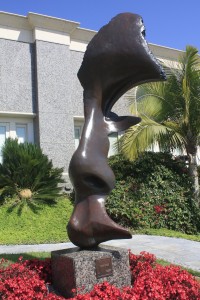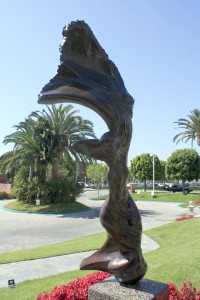By Lila Crespin, Ph.D. | Newport Beach Arts Foundation
Let’s say you’re walking on your way to the bank, and you notice a sculpture placed in the landscape. Being a person who really appreciates public art, you stop and admire it, and then look for the plaque that tells you who the artist is, when the work was created, and it’s name.
Information like this lets you in to what is being depicted; what the artist was after and wants to say. If none of that information is available, frustration can set in, but don’t let it. There is a way.
 If it’s an abstract art work or one that we call “non-objective” (i.e., shapes, line, or color without any reference to the real world), many viewers are stuck. Do you walk away and feel frustrated? No. There is a way to know about a work of art without a museum docent at your elbow.
If it’s an abstract art work or one that we call “non-objective” (i.e., shapes, line, or color without any reference to the real world), many viewers are stuck. Do you walk away and feel frustrated? No. There is a way to know about a work of art without a museum docent at your elbow.
Try asking and answering the following questions about what is in front of you. Hint: you can do this discreetly and not risk being locked up for talking to yourself in public.
This works even better if another human is in your company; actually, lively discourse is the best way to find the meaning of the work. It also works with paintings and other art objects.
• Question 1: What is the dynamic state of the work? Describe how the work makes you feel. Do you feel that it is a calm, easy to understand piece of art? Then we say the work is “leveled.” Is the work difficult to understand? Does it give you a disquieting feeling? Confusion, perhaps? Then we say the work is “sharpened.” Sharpened works of art will usually hold your attention longer than leveled ones.
• Question 2: What do I see? Describe everything that the artist put into making the work: shape, line, color, texture, space, balance, repetition, etc. Find everything you can in the work. Don’t leave outanything. It’s all important or the artist wouldn’t have included it.
• Question 3: What is this artwork about? Every artwork has a message in it. The artist is communicating to you, the viewer, what he or she wants to say. Monet’s water lily paintings are very leveled works of art. Monet spoke of their beauty and their place in his home garden. He wants you to enjoy the tranquility, luscious color, natural beauty, and harmony that he enjoyed when at home. Conversely, “Judith Beheading Holofernes,” the painting of a violent biblical act by Caravaggio is definitely meant to give you a feeling of a sharpened dynamic state at the horror of it all.
wants to say. Monet’s water lily paintings are very leveled works of art. Monet spoke of their beauty and their place in his home garden. He wants you to enjoy the tranquility, luscious color, natural beauty, and harmony that he enjoyed when at home. Conversely, “Judith Beheading Holofernes,” the painting of a violent biblical act by Caravaggio is definitely meant to give you a feeling of a sharpened dynamic state at the horror of it all.
• Question 4: How do you know what the artwork is about? You know because you described what you saw from Questions 1 through 3. You answered each question honestly and objectively by what you found in the work. Your answers for 1 through 3 are the proof you need for Question 4.
Let me know how you practiced this brief system for finding out what an artwork is about on your own. My email address is below. Don’t forget to include the name of the art that you “studied” and where it is placed so that I can see it, too. We’ll compare notes.
The mission of the Newport Beach Arts Foundation is to promote and broaden cultural activities in the community as the fund-raising organization of the Newport Beach Arts Commission. We welcome new members. If you are interested in joining, please contact Lila Crespin at babajoy28@gmail.com.




